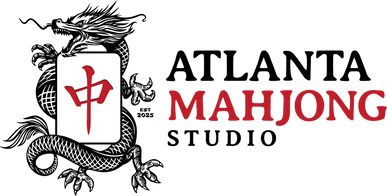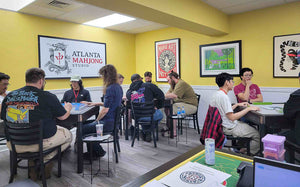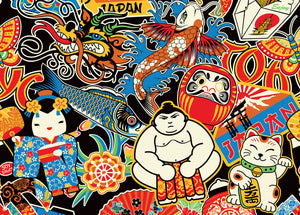So You Want to Learn Riichi Mahjong in Atlanta
If you’ve ever seen Japanese mahjong — Riichi mahjong — you probably thought:
“Wow, that looks serious.”
It is.
But it’s also one of the most exciting, beautifully structured versions of the game. Riichi is the Japanese evolution of traditional mahjong. It uses the same tiles you’d see in Chinese or Hong Kong style but adds layers of strategy, winning hand conditions (yaku), and that dramatic “Riichi!” declaration that turns every round into a psychological battle.
It’s what happens when mahjong and poker have a highly disciplined, math-loving child.
At Atlanta Mahjong Studio, we love Riichi. But we also love seeing people enjoy learning it, not panic halfway through a one-night lesson at a bar because someone just yelled “Kan!” and no one knows what to do.
Step One: Learn Hong Kong Style First
Hong Kong mahjong is the foundation for almost everything else.
It teaches rhythm, table flow, and how to recognize winning shapes (tenpai), but without the mental gymnastics of Riichi scoring.
And here’s the thing: it isn’t homework. Hong Kong style is fun. It’s quick, social, and full of those satisfying “I just drew the exact tile I needed” moments. Even if you never move on to Riichi, it’s a fantastic style on its own.
At the studio, we offer both Hong Kong Beginner and Hong Kong Advanced classes. The better you know Hong Kong, the easier the jump to Riichi will be, because the flow, tile logic, and decision-making all carry over.
That’s why we recommend starting there if you’re new to Asian-style mahjong. It gives you the rhythm, confidence, and instincts that make Riichi feel natural instead of overwhelming.
(And you’ll thank yourself later when the Riichi scoring stick doesn’t make your brain short-circuit.)
What About American Mahjong Players?
If you already play American-style mahjong, you’ve got a head start. You know the tiles, the rhythm, and how turns move.
But the similarities stop there.
American mahjong is based on set hands printed on an annual card, uses jokers, and includes passing rounds that simply don’t exist in Riichi. Japanese and Hong Kong mahjong are open systems. You build your own hand from scratch as the round unfolds.
That’s why we encourage even seasoned American players to start with Hong Kong style first. It’s the perfect bridge: familiar enough to feel comfortable but structured like Riichi so the transition is smooth instead of jarring.
And in Atlanta, where American mahjong is super popular, that bridge matters. Learning Riichi without that foundation can feel like suddenly switching from Uno to poker—both use cards, but are very different games.
Step Two: Learn Riichi the Right Way (Through Play)
Riichi isn’t actually hard; it just has layers.
(Like a croissant. Or an ogre, if you're a Shrek fan.)
Our Japanese Riichi Mahjong Course is divided into five lessons, each designed to build your understanding through actual play, not lectures.
You’ll learn new concepts in short bursts, then spend most of the class playing hands, seeing situations unfold, and learning to recognize them in real time. That way, the ideas stick, and you don’t have to keep flipping through rule sheets to remember what yaku means.
Because classes are small, Mrs. K adjusts each session to fit the group. She slows down when something needs more time or dives deeper when players are ready for the next challenge. No two groups learn exactly the same way, and that’s part of what makes it fun
At least half of every class is spent playing, not just listening. And since we use automatic tables, you’ll never waste time shuffling or building walls. You can focus on learning, experimenting, and asking questions.
Why We Teach It This Way
Riichi can look intimidating, but it shouldn’t feel that way. The only reason it gets overwhelming is when people try to cram everything into a single night, as sometimes happens at restaurant/bar mahjong events where half the players are also ordering drinks and appetizers.
We’ve seen it all: people watch Riichi tournaments online, get inspired, and show up at open play ready to learn it on the fly. That’s like showing up to your first boxing match because you once watched Rocky.
Our approach works because it’s hands-on and flexible. You’ll play, make mistakes, and see how those decisions play out—safely, with Mrs. K guiding you and adjusting the pace as you go. By the end, you’ll have real table awareness, not just trivia.
Many of our Riichi students move on to open play sessions or even competitive events like the World Riichi League Minor we host right here in Atlanta at our studio. When you finish the course, you’ll already have a community waiting to play with you.






